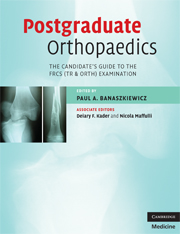Book contents
- Frontmatter
- Contents
- List of contributors
- Foreword by Mr Peter Gibson
- Preface
- Glossary
- Section 1 The FRCS (Tr & Orth) examination
- Section 2 The written paper
- Section 3 The clininicals
- 3 The short cases
- 4 Short case list
- 5 The long cases
- 6 Long case list
- 7 Hand and wrist clinical cases
- 8 Shoulder and elbow clinical cases
- 9 Spine clinical cases
- 10 Hip clinical cases
- 11 Knee clinical cases
- 12 Foot and ankle clinical cases
- 13 Paediatric clinical cases
- Section 4 Adult elective orthopaedics oral
- Section 5 The hand oral
- Section 6 The paediatric oral
- Section 7 The trauma oral
- Section 8 The basic science oral
- Section 9 Miscellaneous topics
- Index
4 - Short case list
from Section 3 - The clininicals
Published online by Cambridge University Press: 22 August 2009
- Frontmatter
- Contents
- List of contributors
- Foreword by Mr Peter Gibson
- Preface
- Glossary
- Section 1 The FRCS (Tr & Orth) examination
- Section 2 The written paper
- Section 3 The clininicals
- 3 The short cases
- 4 Short case list
- 5 The long cases
- 6 Long case list
- 7 Hand and wrist clinical cases
- 8 Shoulder and elbow clinical cases
- 9 Spine clinical cases
- 10 Hip clinical cases
- 11 Knee clinical cases
- 12 Foot and ankle clinical cases
- 13 Paediatric clinical cases
- Section 4 Adult elective orthopaedics oral
- Section 5 The hand oral
- Section 6 The paediatric oral
- Section 7 The trauma oral
- Section 8 The basic science oral
- Section 9 Miscellaneous topics
- Index
Summary
Not an exhaustive list but big enough to stir up uncomfortable feelings of hard work ahead. Try to imagine the typical scenario of each case, the likely positive clinical findings and possible questions the examiners will ask afterwards.
Shoulder
Acromioclavicular joint (ACJ) dislocation
ACJ pain
Brachial plexus muscle power testing
Clavicular non-union
Erb's palsy
Frozen shoulder
Impingement tests
Instability of the shoulder post trauma
Instability testing – unidirectional and multidirectional
Klippel–Feil syndrome
Long head of biceps rupture
Osteoarthritis of the shoulder
Pseudoarthrosis of the clavicle
Pseudoparalysis of the shoulder (septic arthritis) – destruction of the humeral head as an infant
Rotator cuff pathology and testing of muscle strength
Voluntary posterior dislocation of the shoulder
Elbow
Bilateral congenital radial head dislocation
Unilateral congenital dislocation of the radial head
Congenital absence of forearm
Cubitus valgus
Cubitus varus
Madelung's deformity plus multiple osteochondromas
Osteoarthritis of the elbow post trauma
Radioulnar synostosis
Rheumatoid elbow
Rheumatoid nodules
Tennis elbow – demonstration of tests
Wrist and hand
Any congenital abnormality – cleft hand, syndactyly, polydactyly, etc.
Bilateral Dupuytren's
Bilateral Dupuytren's plus peripheral neuropathy
Carpometacarpal osteoarthritis
Combined nerve lesions
Deformed hands due to Ollier's disease
Demonstration of Allen's test
EPL rupture
Ganglion right middle finger
Kienböck's disease
Madelung's disease
Non-union of radius and ulna
Quadriga effect
Rheumatoid hand
RSD post ulnar fracture
Severe carpal tunnel syndrome
SLAC and SNAC wrist
Spaghetti wrists
Ulnar claw hand
Wrist drop
Hip
Osteoarthritis of the hip secondary to AVN post ORIF acetabular fracture
Perthes with secondary osteoarthritic changes
Untreated developmental dysplasia of the hip
Osteoarthritis of the hip
- Type
- Chapter
- Information
- Postgraduate OrthopaedicsThe Candidate's Guide to the FRCS (TR & Orth) Examination, pp. 15 - 16Publisher: Cambridge University PressPrint publication year: 2008



